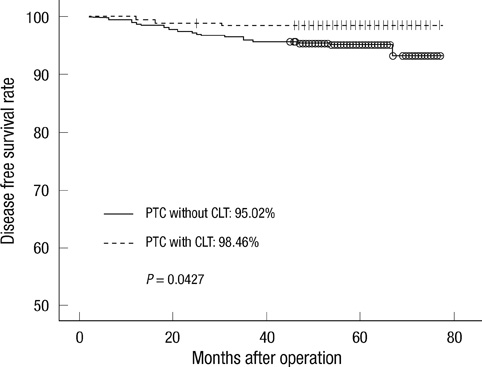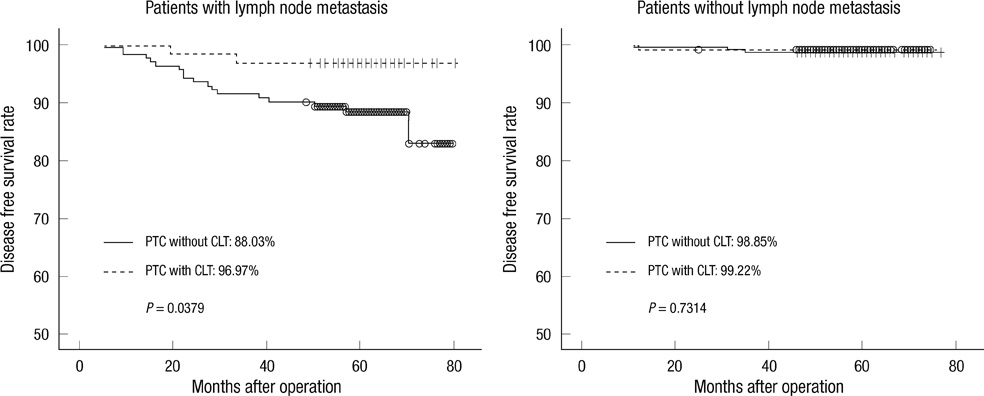Coexistence of Chronic Lymphocytic Thyroiditis with Papillary Thyroid Carcinoma: Clinical Manifestation and Prognostic Outcome
- Affiliations
-
- 1Department of Surgery, Yonsei University College of Medicine, Seoul, Korea. jungjongj@yuhs.ac
- 2Department of Pathology, Yonsei University College of Medicine, Seoul, Korea.
- KMID: 1714199
- DOI: http://doi.org/10.3346/jkms.2012.27.8.883
Abstract
- The study aimed to identify the clinical characteristics of coexisting chronic lymphocytic thyroiditis (CLT) in papillary thyroid carcinoma (PTC) and to evaluate the influence on prognosis. A total of 1,357 patients who underwent thyroid surgery for PTC were included. The clinicopathological characteristics were identified. Patients who underwent total thyroidectomy (n = 597) were studied to evaluate the influence of coexistent CLT on prognosis. Among the total 1,357 patients, 359 (26.5%) had coexistent CLT. In the CLT group, the prevalence of females was higher than in the control group without CLT (P < 0.001). Mean tumor size and mean age in the patients with CLT were smaller than without CLT (P = 0.040, P = 0.047, respectively). Extrathyroidal extension in the patients with CLT was significantly lower than without CLT (P = 0.016). Among the subset of 597 patients, disease-free survival rate in the patients with CLT was significantly higher than without CLT (P = 0.042). However, the multivariate analysis did not reveal a negative association between CLT coexistence and recurrence. Patients with CLT display a greater female preponderance, smaller size, younger and lower extrathyroidal extension. CLT is not a significant independent negative predictive factor for recurrence, although presence of CLT indicates a reduced risk of recurrence.
Keyword
MeSH Terms
-
Adult
Carcinoma/complications/*diagnosis/surgery
Carcinoma, Papillary/complications/*diagnosis/surgery
Disease-Free Survival
Female
Follow-Up Studies
Hashimoto Disease/complications/mortality/*pathology
Humans
Lymphatic Metastasis
Male
Middle Aged
Neoplasm Staging
Odds Ratio
Predictive Value of Tests
Prognosis
Recurrence
Sex Factors
Survival Rate
Thyroid Neoplasms/complications/*diagnosis/surgery
Thyroidectomy
Figure
Cited by 3 articles
-
Pathologic Spectrum of Lymphocytic Infiltration and Recurrence of Papillary Thyroid Carcinoma
Hyun Gi Kim, Eun-Kyung Kim, Kyung Hwa Han, Hyunki Kim, Jin Young Kwak
Yonsei Med J. 2014;55(4):879-885. doi: 10.3349/ymj.2014.55.4.879.Expression of Sodium-Iodide Symporter Depending on Mutational Status and Lymphocytic Thyroiditis in Papillary Thyroid Carcinoma
Young Shin Song, Young Joo Park
Int J Thyroidol. 2018;11(2):152-159. doi: 10.11106/ijt.2018.11.2.152.Associations between Hashimoto Thyroiditis and Clinical Outcomes of Papillary Thyroid Cancer: A Meta-Analysis of Observational Studies
Shinje Moon, Hye Soo Chung, Jae Myung Yu, Hyung Joon Yoo, Jung Hwan Park, Dong Sun Kim, Young Joo Park
Endocrinol Metab. 2018;33(4):473-484. doi: 10.3803/EnM.2018.33.4.473.
Reference
-
1. Hodgson NC, Button J, Solorzano CC. Thyroid cancer: is the incidence still increasing? Ann Surg Oncol. 2004. 11:1093–1097.2. Dailey ME, Lindsay S, Skahen R. Relation of thyroid neoplasms to Hashimoto disease of the thyroid gland. AMA Arch Surg. 1955. 70:291–297.3. Kim EY, Kim WG, Kim WB, Kim TY, Kim JM, Ryu JS, Hong SJ, Gong G, Shong YK. Coexistence of chronic lymphocytic thyroiditis is associated with lower recurrence rates in patients with papillary thyroid carcinoma. Clin Endocrinol (Oxf). 2009. 71:581–586.4. Kebebew E, Treseler PA, Ituarte PH, Clark OH. Coexisting chronic lymphocytic thyroiditis and papillary thyroid cancer revisited. World J Surg. 2001. 25:632–637.5. Okayasu I, Fujiwara M, Hara Y, Tanaka Y, Rose NR. Association of chronic lymphocytic thyroiditis and thyroid papillary carcinoma. A study of surgical cases among Japanese, and white and African Americans. Cancer. 1995. 76:2312–2318.6. Loh KC, Greenspan FS, Dong F, Miller TR, Yeo PP. Influence of lymphocytic thyroiditis on the prognostic outcome of patients with papillary thyroid carcinoma. J Clin Endocrinol Metab. 1999. 84:458–463.7. Holm LE, Blomgren H, Lowhagen T. Cancer risks in patients with chronic lymphocytic thyroiditis. N Engl J Med. 1985. 312:601–604.8. Singh B, Shaha AR, Trivedi H, Carew JF, Poluri A, Shah JP. Coexistent Hashimoto's thyroiditis with papillary thyroid carcinoma: impact on presentation, management, and outcome. Surgery. 1999. 126:1070–1076.9. Kashima K, Yokoyama S, Noguchi S, Murakami N, Yamashita H, Watanabe S, Uchino S, Toda M, Sasaki A, Daa T, et al. Chronic thyroiditis as a favorable prognostic factor in papillary thyroid carcinoma. Thyroid. 1998. 8:197–202.10. Lee MJ, Lee BK, Youn HJ, Jung SH. Is Hashimoto's thyroiditis associated with the prognostic factor of papillary thyroid carcinoma. Korean J Endocr Surg. 2010. 10:29–33.11. Del Rio P, Cataldo S, Sommaruga L, Concione L, Arcuri MF, Sianesi M. The association between papillary carcinoma and chronic lymphocytic thyroiditis: does it modify the prognosis of cancer? Minerva Endocrinol. 2008. 33:1–5.12. Koo BS, Yoon YH, Kim JM, Choi EC, Lim YC. Predictive factors of level IIb lymph node metastasis in patients with papillary thyroid carcinoma. Ann Surg Oncol. 2009. 16:1344–1347.13. Mercante G, Frasoldati A, Pedroni C, Formisano D, Renna L, Piana S, Gardini G, Valcavi R, Barbieri V. Prognostic factors affecting neck lymph node recurrence and distant metastasis in papillary microcarcinoma of the thyroid: results of a study in 445 patients. Thyroid. 2009. 19:707–716.14. Sciuto R, Romano L, Rea S, Marandino F, Sperduti I, Maini CL. Natural history and clinical outcome of differentiated thyroid carcinoma: a retrospective analysis of 1503 patients treated at a single institution. Ann Oncol. 2009. 20:1728–1735.15. Sanders LE, Cady B. Differentiated thyroid cancer: reexamination of risk groups and outcome of treatment. Arch Surg. 1998. 133:419–425.16. Hay ID, Bergstralh EJ, Goellner JR, Ebersold JR, Grant CS. Predicting outcome in papillary thyroid carcinoma: development of a reliable prognostic scoring system in a cohort of 1779 patients surgically treated at one institution during 1940 through 1989. Surgery. 1993. 114:1050–1057.17. Hunt JL, Baloch ZW, Barnes L, Swalsky PA, Trusky CL, Sesatomi E, Finkelstein S, LiVolsi VA. Loss of heterozygosity mutations of tumor suppressor genes in cytologically atypical areas in chronic lymphocytic thyroiditis. Endocr Pathol. 2002. 13:321–330.18. Cooper DS, Doherty GM, Haugen BR, Kloos RT, Lee SL, Mandel SJ, Mazzaferri EL, McIver B, Pacini F, Schlumberger M, et al. Revised American Thyroid Association management guidelines for patients with thyroid nodules and differentiated thyroid cancer. Thyroid. 2009. 19:1167–1214.19. Hundahl SA, Fleming ID, Fremgen AM, Menck HR. A National Cancer Data Base report on 53,856 cases of thyroid carcinoma treated in the U.S., 1985-1995. Cancer. 1998. 83:2638–2648.20. Treseler PA, Clark OH. Prognostic factors in thyroid carcinoma. Surg Oncol Clin N Am. 1997. 6:555–598.21. DeGroot LJ, Kaplan EL, McCormick M, Straus FH. Natural history, treatment, and course of papillary thyroid carcinoma. J Clin Endocrinol Metab. 1990. 71:414–424.22. Bagnasco M, Venuti D, Paolieri F, Torre G, Ferrini S, Canonica GW. Phenotypic and functional analysis at the clonal level of infiltrating T lymphocytes in papillary carcinoma of the thyroid: prevalence of cytolytic T cells with natural killer-like or lymphokine-activated killer activity. J Clin Endocrinol Metab. 1989. 69:832–836.23. Lucas SD, Karlsson-Parra A, Nilsson B, Grimelius L, Akerstrom G, Rastad J, Juhlin C. Tumor-specific deposition of immunoglobulin G and complement in papillary thyroid carcinoma. Hum Pathol. 1996. 27:1329–1335.24. Cunha LL, Ferreira RC, Marcello MA, Vassallo J, Ward LS. Clinical and pathological implications of concurrent autoimmune thyroid disorders and papillary thyroid cancer. J Thyroid Res. 2011. 2011:387062.25. Giordano C, Stassi G, De Maria R, Todaro M, Richiusa P, Papoff G, Ruberti G, Bagnasco M, Testi R, Galluzzo A. Potential involvement of Fas and its ligand in the pathogenesis of Hashimoto's thyroiditis. Science. 1997. 275:960–963.26. Kimura H, Yamashita S, Namba H, Tominaga T, Tsuruta M, Yokoyama N, Izumi M, Nagataki S. Interleukin-1 inhibits human thyroid carcinoma cell growth. J Clin Endocrinol Metab. 1992. 75:596–602.
- Full Text Links
- Actions
-
Cited
- CITED
-
- Close
- Share
- Similar articles
-
- Coexistence of Chronic Lymphocytic Thyroiditis with Papillary Thyroid Carcinoma: Clinical Manifestation and Prognostic Outcome
- Malignant Lymphoma of Thyroid Associated with Chronic Lymphocytic Thyroiditis and Occult Sclerosing Carcinoma: A case report
- Lymphocyte Rich Papillary Oxyphilic Carcinoma of Thyroid
- Ultrasonographic Findings of Papillary Thyroid Cancer with or without Hashimoto's Thyroiditis
- Expression of Sodium-Iodide Symporter Depending on Mutational Status and Lymphocytic Thyroiditis in Papillary Thyroid Carcinoma



